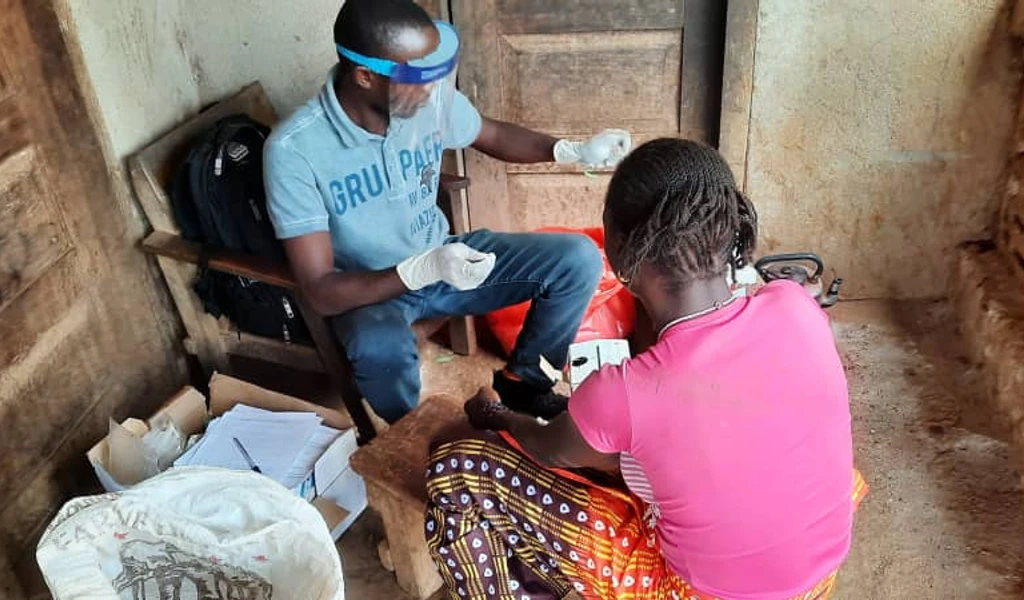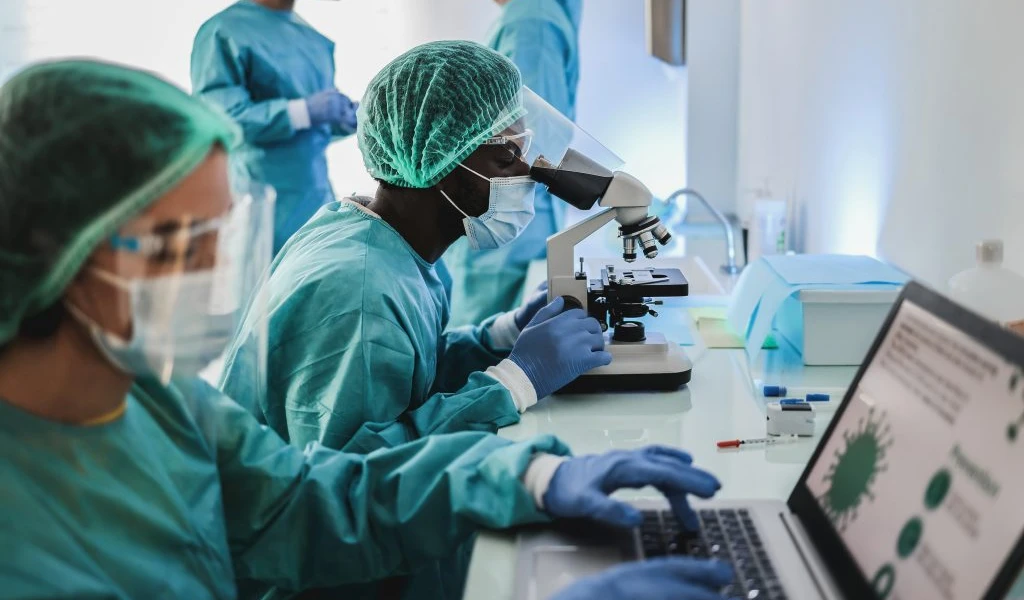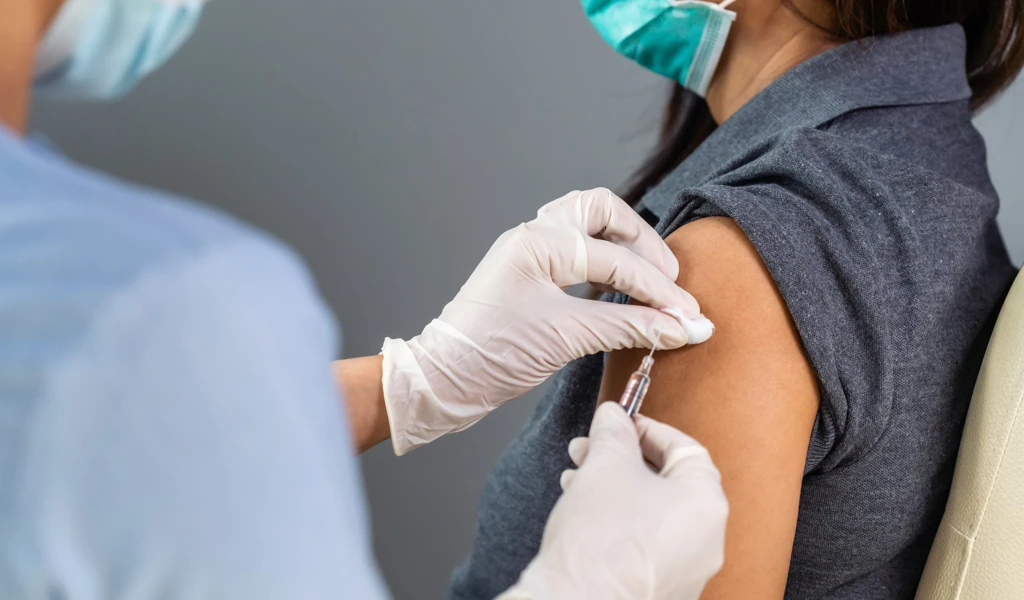Reflections on 2021 from CEPI CEO Dr Richard Hatchett
CEPI CEO Dr Richard Hatchett offers his personal reflections on the events of the past year, and looks to the challenges ahead as the world responds to Omicron and prepares for the threat of future pandemics.
Photo credit: UNICEF/UN0445831/Shrestha
As I reflect on this extraordinary, often frustrating, certainly exhausting, and sometimes exhilarating year now past, let me start by wishing all of you good health, the grace of the season, and a few weeks of respite, as circumstances allow, with friends and family. For some of you this holiday season may be one marked, sadly, by the loss over the last year of beloved friends or family members; and for many, your mood may be dampened considerably by enforced separation or the stress that we have all carried through a difficult year. Please know that you are not alone. The burden of the world's cares hangs heavy for many this year, and I hope that all of you feel your own spirits lifted and can find and spread joy through acts of empathy and compassion over the holidays.
With respect to the challenges we currently face, it is a good moment to pause and take stock. Last year ended more hopefully, certainly, with the arrival in quick succession of several safe and effective COVID-19 vaccines and the prospect of global vaccination campaigns ramping up quickly. And these campaigns have ramped up quickly in many parts of the world, along with other aspects of the response. Without downplaying the work that still remains to be done, or the ways in which we have not fully achieved our ambitions, what has been accomplished in the last two years, in the struggle against COVID-19, is nothing short of extraordinary — in scale, and arguably by other measures, the greatest collective scientific and public health achievement in history: the mobilization of humankind's massive intellectual and industrial resources to understand, track, and fight a viral foe.
More than nine billion doses of vaccine have been manufactured in the year since the first vaccines were authorized; more than eight billion doses have been administered; and substantially more than half of the world's population has received a first dose as I write this. Collectively, we have developed diagnostics and multiple therapeutics; probed the pathogenesis and improved the clinical management of COVID-19 disease; sequenced more than six million viral isolates; established new institutional arrangements to coordinate the global response and reduce the inequities that have emerged; and mobilized tremendous financial resources to enable the battle against the virus. We should all take pride in our contributions to this huge and historic collective effort, even as we lament the vast inequities that have stained it and acknowledge that the struggle against the virus goes on. Acknowledging what remains to be accomplished should not diminish the enormity of what has.
This year has presented tremendous challenges, though. Despite the tools we've developed and despite the unprecedented effort to deploy them, the virus has stayed ahead of us, mutating, gaining speed, and causing wave after wave of infection. The number of documented cases worldwide has increased by more than 200 million in the year since the first vaccines were authorized, at an average of over 540,000 cases a day (slightly more than the 522,137 cases recorded on December 8, 2020, the day Margaret Keenan received the first dose of vaccine offered outside of a clinical trial). Deaths have more than tripled, averaging almost 10,000 a day worldwide over the last year (9,305 were recorded the day vaccinations began). We may have stopped the epidemic's exponential growth, but we have by no means stopped the virus.
We also saw a terrible chasm emerge between rich and poor countries in terms of their access to these tools, especially vaccine. We have behaved, I am sad to say, more or less like the passengers on the Titanic: during the period of greatest scarcity, political forces did not allow us to do better, really, than sauve qui peut. COVAX struggled for most of the year to secure doses that had been locked up in advance purchase agreements by wealthy countries or restricted from export from manufacturing countries because of pressing domestic needs. Many countries initiated the vaccination of children or booster programs for adults before the poorest countries had vaccinated even a tiny fraction of their populations. Thankfully, these supply shortages began to ease in September, as wealthy countries started to donate doses and deliveries from manufacturers picked up. I am pleased to say that COVAX delivered approximately 150 million doses in November, with even more anticipated for this month. On December 5, COVAX delivered 19 million doses on a single day. The ice jam seems finally to have broken. The thousands of people working together to make this happen are among the unsung heroes of the pandemic.
And now, as we turn towards the new year, we face the emergence of a new threat in the highly mutated Omicron variant. Omicron, as I'm sure all of you know, combines the worst features of previous variants: it is very clearly highly transmissible and may soon outcompete Delta in many European countries. If that happens it will likely become the dominant strain globally, generating a new global wave of infections. Omicron also includes multiple mutations that make it less susceptible to the immune response elicited by prior infection or our current vaccines (and we know that antibodies against SARS-CoV-2 wane quickly in any case, although protection against severe disease may be preserved). There is emerging evidence that Omicron may be less virulent than other variants, although it is too early to be definitive about this. But we can't be complacent: even if we are lucky and Omicron does cause less severe disease, its uncontrolled spread could still severely strain already overburdened healthcare systems. Governments in Europe are beginning to implement new lockdowns and restrictions to prevent this from happening, and it is likely that other regions will follow suit.
Whatever its ultimate impact, I believe the emergence of Omicron will come to be seen as a watershed event in the unfolding of the pandemic. Policymakers and elected officials should pay close attention to what Omicron is telling us. It encapsulates both how far we have come, even since 2020, and how far we have yet to go. And it portends our future with COVID.
Let me unpack those statements.
The good news first: we've established an entirely new benchmark in responding to an emerging threat. The speed and alacrity of our response has been impressive — Omicron appears to have been detected quickly, due to increased testing and sequencing in South Africa and Botswana, and those countries are to be commended for recognizing the nature of the threat and sharing information with the rest of the world so promptly, even at the cost of transient international quarantines being imposed on them. The world, in turn, has moved with unprecedented speed to characterize the biology, immunology, and clinical presentation of the new variant, as well as its impact on countermeasures. Dozens of scientific and clinical assessments have already been published as pre-prints, for a variant that was first recognized less than a month ago. Vaccine manufacturers moved within days, of their own accord, to begin developing new candidate vaccines, and updated mRNA vaccines could potentially become available in just three or four months — very close to the 100-day target CEPI and the G7 have articulated as a goal for future responses.
We must read the writing on the wall, however: the future Omicron portends is one in which new COVID variants will continue to emerge periodically, with some having the potential to cause new waves of infection globally — essentially new pandemics — as they progressively evolve away from the strains targeted by our vaccines. Just like flu. We have seen this rapid global spread of a new variant with Delta and we are seeing it now with Omicron. The upshot is that we now have two globally circulating viruses, in influenza and SARS-CoV-2, with the potential to cause new pandemics at any time. That should frighten us.
We do not want to live in a world in which we must develop and administer new boosters every time a new, dangerous COVID variant emerges. If you accept that hypothesis, then you should agree that we need better, more broadly protective, more durable COVID vaccines. And if we want them, we will need, collectively, to invest in the research and development to produce them. This should be a matter of the greatest urgency, and something we pursue even as we do everything we can to deploy the vaccines that we have to greatest effect. So even as we continue our work with COVAX, advance our portfolio of first-generation vaccines, and support clinical trials and real-world efficacy studies to understand how best to use them, CEPI has also included developing broadly protective SARS-CoV-2 and Betacoronavirus vaccines as one of the central elements of our CEPI 2.0 strategy.
Recently I spoke with a senior government official who expressed frustration with the G20 for, in his eyes, too quickly turning its attention to future preparedness. How can we turn our attention to future threats, he said, in the midst of an unresolved crisis? Worrying about preparedness for the next threat he perceived as a luxury that only rich countries, with highly vaccinated populations, can afford — and he felt strongly that focusing on such threats would divert attention from the urgent needs of the moment.
I empathize with his concern, even as I to a certain extent disagree with him. He is correct that as much as the world has accomplished, its leaders have not risen fully to the challenge presented by COVID. We are in an all-consuming struggle with an adversary that is evolving in response to the steps we are taking to defeat it. Half-measures will not vanquish it. Treating the delivery of countermeasures to low- and low-middle income countries as a development "problem" is wholly inadequate. We must substantially step up our response, and not be distracted from it, if we are to bring the pandemic to an end. To that extent, I agree with the frustrated official.
But we must also use the momentum the pandemic has created to institutionalize and improve our new response capabilities and to drive the creation of new norms of collective action and accountability. The response to Omicron, in its positive aspects, exemplifies the ways in which we must be ready to respond to any future threat and the speed and seriousness with which we must act to counter it even as we perform our assessments and gather information. Omicron's emergence also provided dramatic backlighting for, and helped propel, the Special Session of the World Health Assembly that convened the week of November 29 to begin deliberations on an international framework or convention on pandemic prevention, preparedness, and response. Developing such a framework or convention will require sustained diplomacy and likely take years but I am confident the effort will succeed and that the agreements achieved at the Special Session will come to be regarded as foundational.
CEPI will contribute to this momentum in the coming months as we begin to implement our CEPI 2.0 agenda. We have already announced seed funding for three programs under our Broadly Protective SARS-CoV-2 Vaccine initiative and will soon announce our first awards to support the development of Broadly Protective Betacoronavirus Vaccines. With Wellcome Leap, we are co-funding 17 different performers under an RNA Readiness and Response (R3) initiative that aims to increase exponentially the number of biologic products that can be designed, developed, and produced every year, reducing their costs and increasing equitable access; and to create a self-sustaining network of manufacturing facilities providing globally distributed, state-of-the-art surge capacity to meet future pandemic needs. In January, we will put out a call to begin the development of our vaccine libraries and issue a report laying out our thinking about how to achieve the 100-Day Mission — all in the lead-up to our March 2022 Global Pandemic Preparedness Summit, hosted by the government of the United Kingdom. The Summit will provide an opportunity for world leaders to demonstrate their support for epidemic and pandemic preparedness, the role research and development can play in enabling such preparedness, the institutional capabilities and norms we need to establish to achieve the 100-Day Mission, the value of collective action against common threats, and the overriding imperative to secure access for all to vaccines and other countermeasures.
The frustrated official I spoke to was right that we have a long way to go in the fight against COVID. Jeremy Farrar, the Director of Wellcome, has said we may still be closer to the beginning of the pandemic than to its end. Our work through COVAX will and must continue. And I am sure that 2022 will present many unforetold challenges, just as 2021 did. But even as we rise to meet whatever 2022 throws at us, we must envision and work toward the future that we desire for the long term.
And how do we accomplish that? A friend, a journalist, had the opportunity recently to travel to Oslo to attend the ceremony honoring his longtime friend and colleague Maria Ressa, who, with Dmitry Muratov, received the 2021 Nobel Peace Prize for her "efforts to safeguard freedom of expression, which is a precondition for democracy and lasting peace." After my friend returned, he called her Nobel Address to my attention as an "important document for our times" (it is; I commend it to you all). Two statements in her Address have stuck with me:
We are standing on the rubble of the world that was, and we must have the foresight and courage to imagine what might happen if we don't act now, and instead, create the world as it should be — more compassionate, more equal, more sustainable. . . .
and
Without facts, you can't have truth. Without truth, you can't have trust. Without trust, we have no shared reality, no democracy, and it becomes impossible to deal with our world's existential problems: climate, coronavirus, the battle for truth.
The first statement calls us to recognize our predicament and to have the courage to imagine and begin working towards a better future. The second reminds us of the conditions required for communities to flourish and to work together to tackle their greatest problems. Courage, foresight, imagination, facts, trust, and a shared reality: lacking these, it will be all but impossible to deal with the challenges ahead. But with them, we can do anything — we can move mountains.


